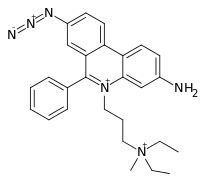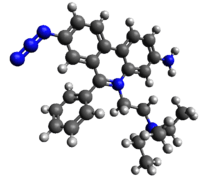Propidium monoazide
 | |
 | |
| Names | |
|---|---|
| IUPAC name
3-Amino-8-azido-5-{3-[diethyl(methyl)ammonio]propyl}-6-phenylphenanthridinium | |
| Identifiers | |
3D model (JSmol) |
|
| ChemSpider | |
PubChem CID |
|
| |
| |
| Properties | |
| C27H32N62+ | |
| Molar mass | 440.582 g/mol |
Except where otherwise noted, data are given for materials in their standard state (at 25 °C [77 °F], 100 kPa). | |
| Infobox references | |
Propidium monoazide (PMA) is a photoreactive DNA-binding dye that preferentially binds to dsDNA. It is used to detect viable microorganisms by qPCR.[1] Visible light (high power halogen lamps or specific LED devices[2]) induces a photoreaction of the chemical that will lead to a covalent bond with PMA and the dsDNA. This will render the DNA non-amplificable by PCR. Dead microorganisms lose their capability to maintain their membranes, which leaves the "naked" DNA in the cytosol ready to react with PMA. Living organisms don't react to the PMA, as they have an intact cell membrane. After treatment with the chemical, only the DNA from living bacteria is usable in qPCR, allowing to obtain only the amplified DNA of living organisms. This is helpful in determining which pathogens are active in specific samples.[3] The main use of PMA is in Viability PCR but the same principle can be applied in flow cytometry or fluorescence microscopy.
PMA was developed at Biotium, Inc.[4] as an improvement on ethidium monoazide (EMA). PMA provides better discrimination between live and dead bacteria because it is excluded from live cells more efficiently than EMA.[5]
References
- ↑ Qiagen, BLU-V Viability. "PMA Kit". Qiagen Website. Retrieved 24 October 2013.
- ↑ GenIUL, Photo activation system for tubes. "PhAST Blue". GenIUL Website. Retrieved 26 January 2014.
- ↑ Nocker, Andreas; Ching-Ying Cheung, and Anne K. Camper (2006). "Comparison of propidium monoazide with ethidium monoazide for differentiation of live vs. dead bacteria by selective removal of DNA from dead cells". Journal of microbiological methods (67.2): 310–320.
- ↑ "PMA dye | Propidium Monoazide | Biotium, Inc". Retrieved 8 March 2016.
- ↑ Nocker, Andreas; Cheung, Ching-Ying; Camper, Anne K. (2006-11-01). "Comparison of propidium monoazide with ethidium monoazide for differentiation of live vs. dead bacteria by selective removal of DNA from dead cells". Journal of Microbiological Methods. 67 (2): 310–320. doi:10.1016/j.mimet.2006.04.015. PMID 16753236.